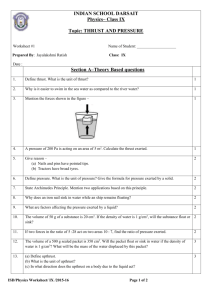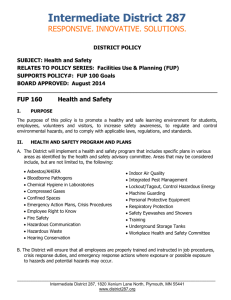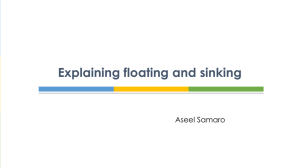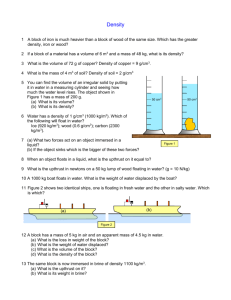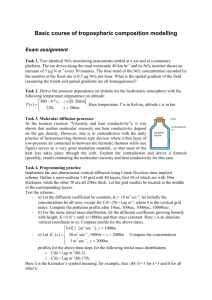Higher Physics – Unit 1
advertisement
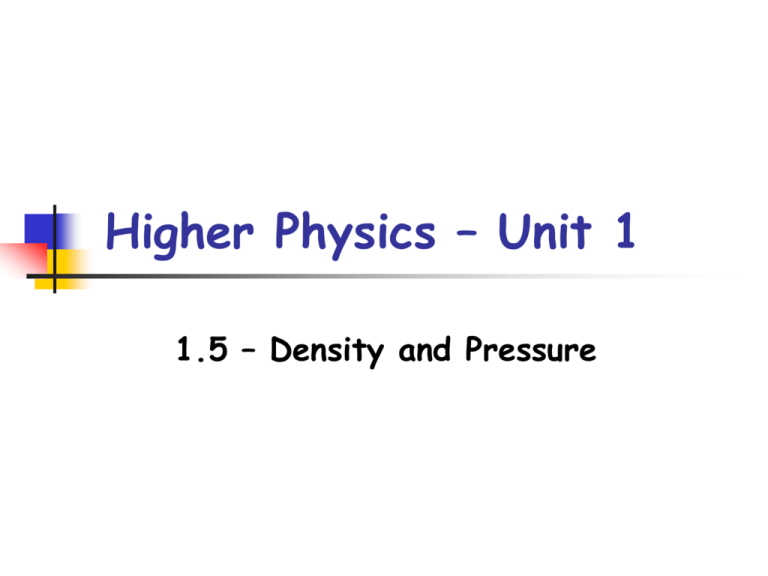
Higher Physics – Unit 1 1.5 – Density and Pressure Density The density of a substance is the mass per unit volume. density (kg m-3) m ρ V mass (kg) volume (m3) The more mass in a given volume, the greater the density. Density has the symbol, ρ (rho). Example 1 A rectangular block of metal measures 20 cm x 15 cm x 10 cm and has a mass of 12 kg. Calculate the density of the metal. V 0.2 0.15 0.1 0.003 m3 m 12 kg ρ? ρ m V 12 0.003 ρ 4,000 kg m 3 Measuring Density of Air Aim To measure and compare the value for the density of air. Method Around bottomed flask is weighed with air inside it. The air is evacuated using a vacuum pump and is reweighed. The volume of the flask is measured by filling it with water and emptying into a measuring cylinder. to vacuum pump air Results mass of flask air g mass of flask no air g mass of air extracted g ρair m V kg ρair volume of air in flask ml litres m3 ρair kg m-3 ** 1000 litres = 1 m3 ** ** Must Be Able To Describe How To Measure Density of Air ** Molecule Separation The molecule separation for each of the three states of matter is considered. solid liquid gas The volume occupied by a substance in its solid form is approximately equal to the volume occupied when in liquid form. The volume of a gas however is 1000 times greater than the volume of the same mass of the solid or liquid form of that substance. 10 d d 10 d 10 d As the mass is contained in a volume which is 1000 times greater, the density is 1000 times smaller. ρ m 1000 V The densities of gases are smaller than the densities of solids and liquids by a factor of 1000. Summary Separation Volume Density Solid 1 1 1 Liquid 1 1 1 Gas 10 1000 1/1000 Pressure The pressure is defined as the force per unit area. pressure (Pa) F P A force (N) area (m2) The unit of pressure is the Pascal (Pa). Alternative units for pressure are: N m-2. 1 Pa 1 N m2 Example 1 A 3 kg block has dimensions as shown. 0.05 m 0.2 m 0.3 m Calculate the pressure the box exerts on the surface of a desk. Weight of Box Wmg 3 9.8 W 29.4 N Area of Base A lb 0.3 0.2 A 0.06 m2 Pressure on Desk F P A 29.4 0.06 P 490 Pa Worksheet – Density and Pressure Q1 – Q20 Pressure in Fluids Fluid is a general term which describes liquids and gases. Any equations that apply to liquids at rest equally apply to gases at rest. Atmospheric Pressure At the Earth’s surface, the air exerts pressure in all directions. This is caused by air molecules which move at high speeds in random directions. When they collide with surfaces they exert a force. The force exerted by the atmosphere is 1x105 N per m2. This force is known as the atmospheric pressure: 1.01 10 Pa 5 At high altitudes there is less atmospheric pressure because there are fewer air molecules and less weight pushing down from above. Pressure in Liquids At the surface of a liquid the pressure is the same as atmospheric pressure. Beneath the surface, the pressure in fluids varies directly with the depth and the density of the liquid. pressure (Pa) P ρgh density (kg m-3) depth (m) gravitational field strength (N kg-1) Graph of Relationship pressure (Pa) pressure (Pa) depth of liquid (m) density of liquid (kg m-3) Example 1 An object at 6 m is placed in a liquid with a density of 800 kg m-3. Calculate the pressure due to the liquid. h 6m P ρgh ρ 800 kg m-3 800 9.8 6 47,040 P 4.7 10 4 Pa g 9.8 N kg-1 P? Example 2 A cube with sides 12 cm is submerged in water to a depth of 30 cm. 30 cm (a) The density of fresh water is 1x103 kg m-3. Calculate the pressure at the bottom surface of the cube due to the water. h 30 cm 0.3 m ρ 1 103 kg m-3 g 9.8 N kg-1 P? P ρgh 1 103 9.8 0.3 P 2,940 Pa (b) Calculate the pressure at the top surface of the cube due to the water. h 30 - 12 18 cm 0.18 m ρ 1 103 kg m-3 g 9.8 N kg-1 P ρgh 1 103 9.8 0.18 P 1,764 Pa P? (c) Calculate the force acting on the bottom surface of the cube. P 2,940 Pa A 0.12 0.12 0.0144 m2 F? FPA 2940 0.0144 F 42.3 N Example 3 – (Atmospheric Pressure) A mooring buoy is tethered to the bottom of a sea water loch by a vertical cable as shown. 1.5 m The density of sea water is 1.02x103 kg m-3. 0.30 m (a) Calculate the total pressure on the top of the buoy. h 1.5 m ρ 1.02 10 kg m 3 g 9.8 N kg-1 P? -3 P ρgh 1.02 103 9.8 1.5 P 14,994 Pa This pressure is only due to the sea water. To find the total pressure, we need to add the atmospheric pressure from the air above. Ptotal 14,994 1.01 105 115,994 Pa 1.16 105 Pa (b) Calculate the total pressure on the bottom of the buoy. h 1.8 m ρ 1.02 10 kg m 3 -3 g 9.8 N kg-1 P? P ρgh 1.02 103 9.8 1.8 P 17,992.8 Pa Ptotal 17,992.8 1.01 105 118,992.8 Pa 1.19 105 Pa Upthrust or Buoyancy To hold an object in a stationary position a force, T, must be applied. T must be equal in size but opposite in direction to the weight, W, of the object. T W When the object is placed on the surface of a liquid the force, T, required to hold it stationary is less than before. T This is because the base of the object experiences an upward force from the liquid. The upward force is called UPTHRUST (Fup). Fup W F Upthrust is caused by the pressure of the liquid on the base area of the object. up On submerging the object further into the liquid, the force, T, required becomes even smaller. This is because as depth increases the pressure increases, hence the upthrust increases. Fup P A P A T h W Fup Maximum Upthrust The MAXIMUM UPTHRUST is achieved just before the object becomes fully submerged. T h After that the pressure on the top surface would cause a downward force cancelling out any further increase in Fup. Fup W Size of Upthrust (Submerged) The size of the upthrust depends on the pressure difference between the top and bottom surface. It does NOT depend on the depth . T T P1 W Fup P3 P2 W Fup P4 T T P1 W Fup P3 P2 W Fup P4 Note • P1 < P3 • P2 < P4 • However, the pressure difference in both situations is the same: P2 P1 P4 P3 • So the upthrust on each object is equal. Flotation Much Less Dense When an object is much less dense than a liquid it will float on the surface. This is because the liquid provides a large enough upthrust to balance the weight of the object, even at the surface. W Fup Slightly Less Dense When an object is only slightly less dense than a liquid it will become submerged to certain depth, h. h Fup W At this depth, the pressure has increased enough to produce an upthrust to balance the weight of the object. More Dense When an object is more dense than a liquid it will sink because the weight is greater than the maximum upthrust (which is achieved just before submersion). sinking W Fup Buoyancy When an object is held below the surface of a more dense liquid it remains there until the force holding it is removed. This is because the UPTHRUST is greater than the weight at this depth due to increased pressure. It will rise to a depth where the pressure is just enough to produce an upthrust equal to the weight of the object. W Fup Worksheet – Pressure in Liquids and Buoyancy Q1 – Q13

